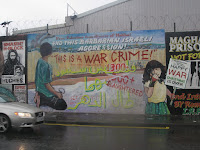The fact is, the best and brightest don‘t want to live in a city defined by division. They don‘t want to live behind walls….The historic cultural barriers between the two communities are slowly coming down, and the sooner they do—and the sooner the physical barriers come down too—the sooner the floodgates of private investment will open.In the same year Tony MaCaulay, Belfast born writer, consultant and community worker wrote a position paper outlining a process for bringing down the walls in Northern Ireland, identifying community-engagement approaches and specific to this discussion here, a 'tipping-point' by which the walls coming down would be of more benefit to the residents living beside the walls than the walls standing tall (http://cain.ulst.ac.uk/issues/segregat/docs/macaulay200708.pdf).
So I wonder, what comes first? Foreign investment to catalyse the 'tipping point' or bringing down the walls to promote foreign investment?
Just a couple hours drive from Belfast lies Derry/Londonderry, or 'the stroke city,' home to different demographic dynamics than Belfast but rife with many similar issues- peace lines, historic walls, and deep seated divisions. This year a £13.4 million 'peace bridge' was built across the River Foyle connecting the divided water-side to the city-side, two parts of the city divided not only by water but also by ethno-religious identities.
The old site of the Ebrington barracks lie across the river on the historically Protestant side of the river. The protected buildings are undergoing extensive renovation and plans are in place for a massive development made up of open space for concerts and events, a shopping centre, dining facilities ect; funded and inspired in part by the investment from the city's 2013 City of Culture award.
 |
| 'Peace bridge' Derry/Londonderry with view of the old Ebrington barracks (2011) |
A city councillor explained to us that the bridge, curved in such a way to symbolise two hands reaching across the divide, was built not only to make communication and mobility easier for the two communities but to encourage investment and provide access to the new Ebrington development.
Here we can clearly see the relationship between peace and investment. The tipping-point for the stroke city to build bridges in place of walls has come at the cost of hundreds of millions of pounds of investment. This has transformed the city-centre, developed new opportunities for the city to become a cultural hub for the island, and promoted tourism for the city to encourage even more revenue.
Well happy days, there you have it! Foreign investment and bridges that symbolise and actualise cross-community (in this case cross-river) connections. There are cases of this from Victoria Square to Castle Court to the Odyssey Complex in Belfast and now to Ebrington in Derry/Londonderry.
But before we end the story, it's important we don't forget the poorest parts of these cities, suffering from the highest levels of deprivation and coping with the most violent legacies of the Troubles. Out of the spotlight of these investment triumphs and victories of peace, there are new walls. A short walk from the new 'peace bridge' plans have been approved for a new peace-line at the Lisnagelvin recreational fields. Although the peace-lines are downplayed on walking tours and these new walls are described as related more to 'anti-social behaviour' than sectarian conflict, a blind eye is turned on enduring legacies of conflict and money is pumped into a new image for the future.
 |
| Peace-line on hill above Bogside (2011) |
 |
| Security Gates Derry/Londonderry (2011) |
What do the people in these interface areas and conflict zones have to say about the potentials of investment?
In the same year of MacCaulay's discussion paper and Mayor Bloomberg's speech (2008), the US-Ireland Alliance and Millward Brown Ulster group conducted an interface poll on attitudes towards the peace lines. In some areas, 50% of people felt tourism and investment would not change if the walls were to come down and 14% felt tourism and investment would decrease (http://www.us- irelandalliance.org/user-assets/Documents/Graphs.pdf).
Taking this into consideration we can see how investment is disproportionately benefiting the people and places of Northern Ireland. The billions of (insert any currency here) may promote regeneration and peace, but not for everyone affected by the conflict.
It is important to view any and all investments as having great potential to promote tourism and regeneration for Northern Ireland; however, it's essential too that the image of peace sold to the world does not overshadow the many divisions, disadvantages, and disparities outlasting the peace-treaty and displacing investment.
Peace is expensive to buy and will be extremely costly to maintain if the many long-standing peace initiatives across Northern Ireland continue to lose funding over the next few years while division is downplayed and shopping centres and romantic symbols of peace act as the bandages of conflict.
 |
| Development site, Belfast (2009) |























